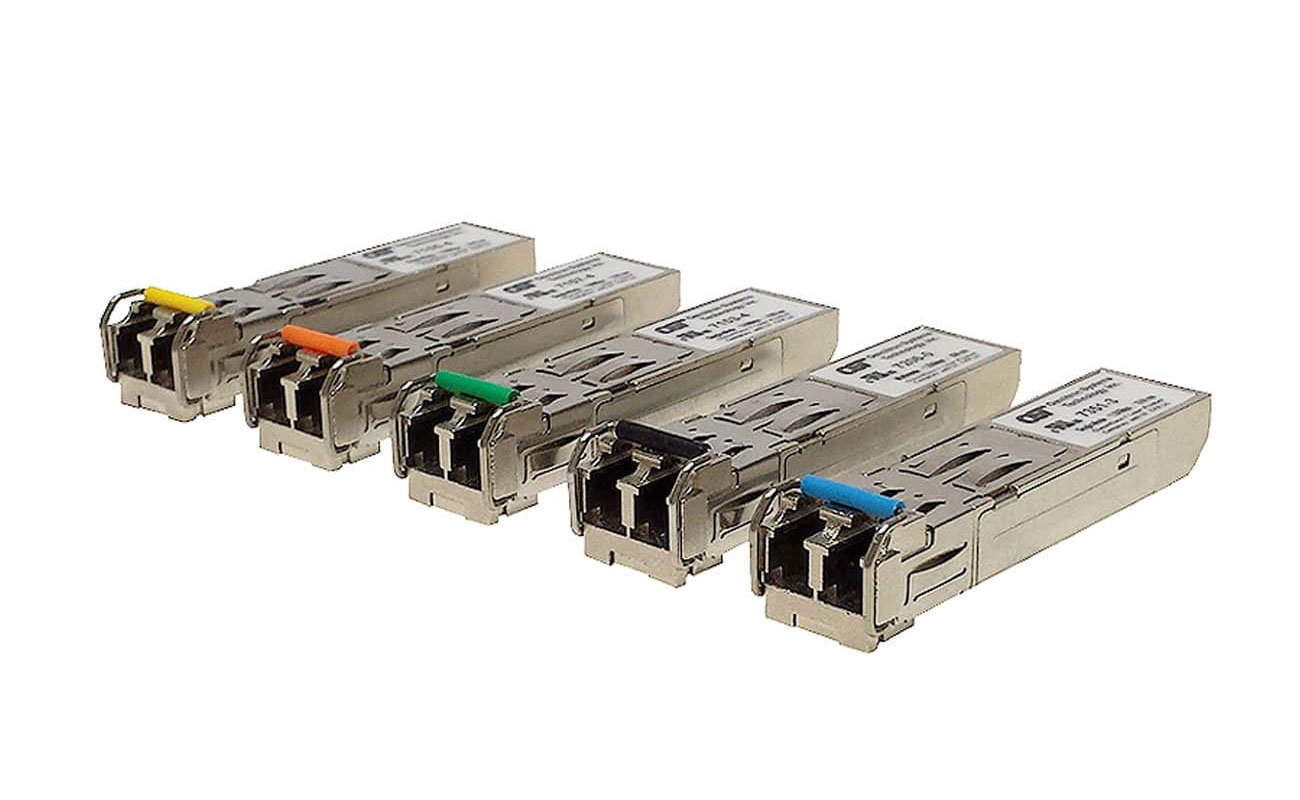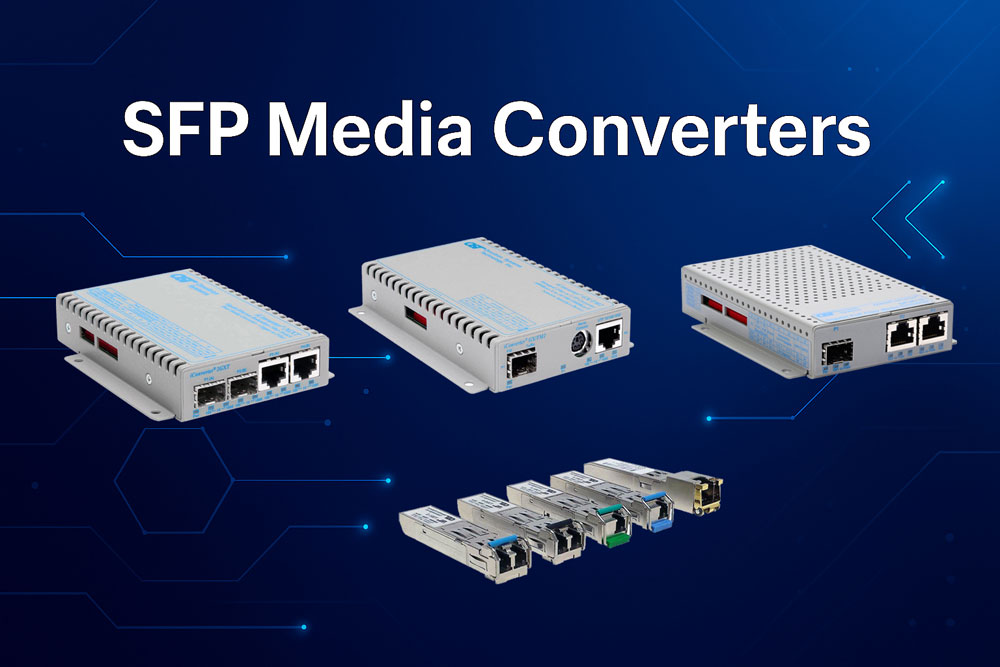Main Menu
Useful Links
Contact us
Follow us
© 2025 Omnitron Systems Technology, Inc. All Rights Reserved. | Privacy Policy

Selecting the right SFP (Small Form-factor Pluggable) media converter is crucial in optimizing the performance of your network. With businesses increasingly relying on robust, scalable infrastructure, choosing a high-quality SFP media converter can significantly enhance network efficiency. At Omnitron Systems, we offer a wide range of SFP media converters that can help you seamlessly integrate fiber and copper connections, ensuring your network performs at its best.
In this blog post, we’ll dive into the important factors you should consider when choosing an SFP media converter, how Omnitron Systems can help you make the right choice, and how to incorporate the benefits of advanced technologies like CWDM (Coarse Wavelength Division Multiplexing) for increased network capacity.
An SFP media converter is a device designed to bridge the gap between different types of network media, most commonly converting electrical signals over copper cables to optical signals transmitted via fiber optic cables. This allows for greater flexibility and reach in network design, especially when businesses need to extend their networks across long distances or between different types of physical infrastructures.
Key benefits of SFP media converters include:
At Omnitron Systems, we offer a variety of SFP media converters to fit diverse network needs, making it easier for your organization to scale its infrastructure efficiently.
Choosing the best SFP media converter for your network involves understanding your specific requirements. Let’s explore some of the critical factors to take into account:
Network speed is one of the most important considerations. Whether you need Gigabit Ethernet for standard office use or 10 Gbps for high-performance environments, your SFP media converter should support the speed necessary for optimal network performance.
Omnitron Systems’ SFP media converters support a broad range of speeds, ensuring that you can find the right converter to meet your network’s specific needs.
When selecting an SFP media converter, understanding the fiber optic standards is essential. Whether you're using Single-Mode Fiber or Multi-Mode Fiber will determine your network’s reach.
Read more: Single-Mode vs. Multimode Fiber Cable
For businesses using CWDM technology, Omnitron Systems offers SFP transceivers for CWDM wavelengths, which provide flexible fiber and copper connectivity between existing equipment and CWDM multiplexers. These transceivers support wavelengths in the ITU-T G.694.2 CWDM spectrum and are designed for long-distance, high-capacity transmission.
Ensure that your SFP media converter is compatible with the existing devices in your network. Omnitron Systems' media converters are compatible with a variety of network products like iConverter, FlexPoint, OmniConverter, RuggedNet, and miConverter products that support SFP transceivers.
Using the right SFP transceiver, including optical CWDM transceivers, can ensure that all your existing network equipment remains integrated and functional, even as you upgrade your infrastructure.
There are many benefits to using an SFP media converter, from extending network reach to enhancing performance:
One of the major advantages of using SFP media converters is their ability to extend your network’s reach. Fiber optics, in particular, allow for longer distances without signal degradation, making them ideal for large campuses or multi-building setups.
For applications that demand longer distance networking, Omnitron Systems’ SFP converters can integrate seamlessly with CWDM systems to increase capacity and extend reach.
CWDM (Coarse Wavelength Division Multiplexing) transceivers are another crucial feature in SFP media converters. Omnitron’s SFP transceivers for CWDM wavelengths enable the use of multiple optical wavelengths (from 1270nm to 1610nm) on the same fiber pair. This significantly increases your network’s bandwidth and capacity, reducing the need for additional cabling infrastructure.
Benefits of using CWDM transceivers:
Omnitron Systems' SFP transceivers, including those used for CWDM applications, come with digital diagnostic capabilities. This feature provides real-time insights into the performance of your network, such as optical transmission power, voltage, and temperature, helping you proactively monitor and manage your network's health.
Some SFP media converters have SFP ports that support multiple Ethernet speeds such as 100Mbps and 1Gbps. The ability to support both speeds allows the devices to be used in a wider range of network applications.
SFP media converters are a cost-effective solution for businesses that want to upgrade to fiber optics without replacing entire network devices. Omnitron Systems provides a wide variety of converters, including CWDM transceivers, which offer flexible, modular solutions that can be easily adapted to your existing infrastructure.

When selecting an SFP media converter, consider these essential steps to make the best decision for your network:
The first step in choosing the right SFP media converter is evaluating your network’s speed and capacity requirements. Network speed is typically measured in Mbps (megabits per second) or Gbps (gigabits per second), and it directly impacts the efficiency of your network. This is a crucial consideration because the speed of the SFP converter must align with the data transfer rate that your network supports.
If your network requires high capacity, one way to significantly increase your bandwidth is by incorporating CWDM transceivers into your setup. CWDM (Coarse Wavelength Division Multiplexing) allows for the transmission of multiple data channels on the same fiber, enabling you to use the same infrastructure but with increased overall bandwidth. This is particularly useful when you're looking to optimize performance without the need for additional cabling or costly upgrades.
Read more: SFP vs. SFP+: What's the Difference?
Next, it’s important to determine the type of fiber optic cabling you need, and how far your data needs to travel, as this will greatly affect the choice of media converter.
Your decision between single-mode and multi-mode fiber should be based on the distance your network needs to cover. If your business is expanding its network over large geographic areas, you’ll want to ensure your SFP media converter supports single-mode fiber for long-distance reliability.
Depending on the fiber type you determine for your application, choose the related SFP for Single-Mode or Multimode fiber.
Choosing an SFP media converter isn’t just about meeting your current needs — it’s also about ensuring that your network can scale and evolve with future demands. As businesses grow, so do their network requirements, and it’s crucial to select a converter that will allow you to upgrade easily without completely overhauling your infrastructure.
When considering future-proofing, here are a few key points:
Omnitron Systems' CWDM optical transceivers support multiple wavelengths, allowing businesses to increase network capacity by using existing fiber infrastructure, reducing the need for additional cables or hardware. This makes future upgrades more affordable and convenient.
| Factor | Considerations | Omnitron Solutions |
|---|---|---|
|
Network Speed Requirements |
- Choose between Gigabit Ethernet (1 Gbps) or 10 Gigabit Ethernet (10 Gbps) based on your needs. |
Omnitron supports 1 Gbps and 10 Gbps speeds for both copper and fiber connections. |
|
Fiber Type |
- Single-Mode Fiber for long distances. - Multi-Mode Fiber for short distances. |
Omnitron offers media converters compatible with both single-mode and multi-mode fiber. |
|
Distance Requirements |
- Single-mode supports distances up to 80 km or more. - Multi-mode supports up to 2 km. |
Omnitron SFP media converters support long-distance transmission with single-mode fiber and short distances with multi-mode fiber. |
|
CWDM Integration |
- For high-capacity networks, CWDM technology can multiplex multiple data channels on the same fiber. |
Omnitron provides SFP CWDM transceivers, allowing multiple wavelengths on a single fiber for increased bandwidth. |
|
Future Scalability |
- Choose converters that can easily scale to higher speeds or add more capacity. |
Omnitron’s SFP transceivers are modular and easily upgradable, providing scalable bandwidth and flexibility. |
|
Diagnostics |
- Look for converters with digital diagnostic capabilities for network monitoring. |
Omnitron SFP media converters support digital diagnostics, providing real-time data on TX/RX power, voltage, and temperature. |
Installing and setting up an SFP media converter is a straightforward process, typically requiring minimal technical expertise. Here's a step-by-step guide to get your SFP media converter up and running:
SFP media converters generally support speeds of up to 1 Gbps, while SFP+ media converters are designed for 10 Gbps networks. The choice between SFP and SFP+ depends on your network speed requirements.
CWDM (Coarse Wavelength Division Multiplexing) allows for multiple data channels to be transmitted on the same fiber pair using different optical wavelengths. This significantly boosts network capacity and efficiency. Each channel is transported on a separate CWDM wavelength. CWDM SFP transceivers will each come with their own specific wavelength on the CWDM spectrum.
Yes, Omnitron’s SFP media converters are standards-based and compatible with a wide range of network devices, including iConverter, FlexPoint, OmniConverter, and other 3rd party equipment. Our CWDM transceivers also provide easy integration with existing network equipment.
Installing an SFP media converter is a straightforward process. Simply insert the SFP transceiver into the converter and connect the fiber optic or copper cables. Omnitron’s products are designed for easy plug-and-play deployment.
Digital diagnostics allow network administrators to monitor real-time performance metrics, such as optical transmission power and temperature. This helps with network management, maintenance, and troubleshooting.
Choosing the right SFP media converter is essential for optimizing your network’s performance, scalability, and efficiency. By considering factors such as speed, fiber type, and the integration of advanced technologies like CWDM, you can ensure your network is prepared for current and future demands.
At Omnitron Systems, we offer a range of SFP media converters designed to meet your unique network needs. From CWDM transceivers to standard Ethernet converters, our products provide cost-effective solutions that enable your business to stay connected and efficient. Let us help you choose the best SFP media converter to optimize your network today! Contact us today!